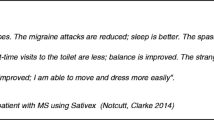Abstract
About 30% of patients with chronic upper motor neuron syndrome (UMNS) suffer from disabling spasticity-related pain not sufficiently correctable by conventional treatment. Delta9-tetrahydrocannabinol (Δ9-THC) was reported to add benefit in the treatment of pain in patients with multiple sclerosis (MS). The question arose whether synthetic cannabinoids with lower potential for psychotropic side effects could be effective as well. To evaluate the safety and efficacy of low dose treatment with the synthetic cannabinoid Nabilone (1 mg per day) on spasticity-related pain a placebo-controlled double-blind crossover trial was performed.
11 out of 13 included patients completed the study. The 11-Point-Box-Test showed a significant decrease of pain under Nabilone (p < 0.05), while spasticity, motor function and activities of daily living did not change. 5 patients reported side effects: one moderate transient weakness of the lower limbs (Nabilone phase, drop out), three mild drowsiness (two Nabilone, one placebo) and one mild dysphagia (placebo). One patient was excluded from the study due to an acute relapse of multiple sclerosis (Nabilone phase, drop out).
Nabilone 1 mg per day proved to be a safe and easily applicable option in the care of patients with chronic UMNS and spasticity-related pain otherwise not controllable.


Similar content being viewed by others
References
Shakespeare DT, Boggild M, Young C (2003) Anti-spasticity agents for multiple sclerosis. Cochrane Database Syst RevCD001332
Beard S, Hunn A, Wight J (2003) Treatments for spasticity and pain in multiple sclerosis: a systematic review. Health Technol Assess 7:iii, ix–iii, 111
Iversen L (2003) Cannabis and the brain. Brain 126:1252–1270
Baker D, Pryce G, Croxford JL, Brown P, Pertwee RG, Makriyannis A, Khanolkar A, Layward L, Fezza F, Bisogno T, Di MV (2001) Endocannabinoids control spasticity in a multiple sclerosis model. FASEB J 15:300–302
Diana G, Malloni M, Pieri M (2003) Effects of the synthetic cannabinoid nabilone on spatial learning and hippocampal neurotransmission. Pharmacol Biochem Behav 75:585–591
Rubin A, Lemberger L, Warrick P, Crabtree RE, Sullivan H, Rowe H, Obermeyer BD (1977) Physiologic disposition of nabilone, a cannabinol derivative, in man. Clin Pharmacol Ther 22:85–91
Ahmedzai S, Carlyle DL, Calder IT, Moran F (1983) Anti-emetic efficacy and toxicity of nabilone, a synthetic cannabinoid, in lung cancer chemotherapy. Br J Cancer 48:657–663
Ward A, Holmes B (1985) Nabilone. A preliminary review of its pharmacological properties and therapeutic use. Drugs 30:127–144
Kurzthaler I, Bodner T, Kemmler G, Entner T, Wissel J, Berger T, Fleischhacker WW (2005) The effect of nabilone on neuropsychological functions related to driving ability: an extended case series. Hum Psychopharmacol 20:291–293
Wissel J, Muller J, Dressnandt J, Heinen F, Naumann M, Topka H, Poewe W (2000) Management of spasticity associated pain with botulinum toxin A. J Pain Symptom Manage 20:44–49
Maurer M, Henn V, Dittrich A, Hofmann A (1990) Delta-9-tetrahydrocannabinol shows antispastic and analgesic effects in a single case double-blind trial. Eur Arch Psychiatry Clin Neurosci 240:1–4
Martyn CN, Illis LS, Thom J (1995) Nabilone in the treatment of multiple sclerosis. Lancet 345:579
Hamann W, di Vadi PP (1999) Analgesic effect of the cannabinoid analogue nabilone is not mediated by opioid receptors. Lancet 353:560
Zajicek J, Fox P, Sanders H, Wright D, Vickery J, Nunn A, Thompson A (2003) Cannabinoids for treatment of spasticity and other symptoms related to multiple sclerosis (CAMS study): multicentre randomised placebo-controlled trial. Lancet 362:1517–1526
Petro DJ, Ellenberger C Jr. (1981) Treatment of human spasticity with delta 9-tetrahydrocannabinol. J Clin Pharmacol 21:413S–416S
Meinck HM, Schonle PW, Conrad B (1989) Effect of cannabinoids on spasticity and ataxia in multiple sclerosis. J Neurol 236:120–122
Brenneisen R, Egli A, Elsohly MA, Henn V, Spiess Y (1996) The effect of orally and rectally administered delta 9-tetrahydrocannabinol on spasticity: a pilot study with 2 patients. Int J Clin Pharmacol Ther 34:446–452
Ungerleider JT, Andyrsiak T, Fairbanks L, Ellison GW, Myers LW (1987) Delta-9-THC in the treatment of spasticity associated with multiple sclerosis. Adv Alcohol Subst Abuse 7:39–50
Greenberg HS, Werness SA, Pugh JE, Andrus RO, Anderson DJ, Domino EF (1994) Short-term effects of smoking marijuana on balance in patients with multiple sclerosis and normal volunteers. Clin Pharmacol Ther 55:324–328
Kogel RW, Johnson PB, Chintam R, Robinson CJ, Nemchausky BA (1995) Treatment of Spasticity in Spinal Cord Injury with Dronabinol, a Tetrahydrocannabinol Derivative. Am J Ther 2:799–805
Killestein J, Hoogervorst EL, Reif M, Kalkers NF, Van Loenen AC, Staats PG, Gorter RW, Uitdehaag BM, Polman CH (2002) Safety, tolerability, and efficacy of orally administered cannabinoids in MS. Neurology 58:1404–1407
Killestein J, Uitdehaag BM, Polman CH (2004) Cannabinoids in multiple sclerosis: do they have a therapeutic role? Drugs 64:1–11
Okie S (2005) Medical Marijuana and the Supreme Court. N Engl J Med 353:648–651
Pertwee RG (2002) Cannabinoids and multiple sclerosis. Pharmacol Ther 95:165–174
Consroe P (1998) Brain cannabinoid systems as targets for the therapy of neurological disorders. Neurobiol Dis 5:534–551
Baker D, Pryce G, Giovannoni G, Thompson AJ (2003) The therapeutic potential of cannabis. Lancet Neurol 2:291–298
Pertwee RG (2001) Cannabinoid receptors and pain. Prog Neurobiol 63:569–611
Consroe P (1998) Brain cannabinoid systems as targets for the therapy of neurological disorders. Neurobiol Dis 5:534–551
Campbell FA, Tramer MR, Carroll D, Reynolds DJ, Moore RA, McQuay HJ (2001) Are cannabinoids an effective and safe treatment option in the management of pain? A qualitative systematic review. BMJ 323:13–16
Attal N, Brasseur L, Guirimand D, Clermond-Gnamien S, Atlami S, Bouhassira D (2004) Are oral cannabinoids safe and effective in refractory neuropathic pain? Eur J Pain 8:173–177
Author information
Authors and Affiliations
Corresponding author
Additional information
Received in revised form: 28 February 2006
Rights and permissions
About this article
Cite this article
Wissel, J., Haydn, T., Müller, J. et al. Low dose treatment with the synthetic cannabinoid Nabilone significantly reduces spasticity-related pain. J Neurol 253, 1337–1341 (2006). https://doi.org/10.1007/s00415-006-0218-8
Received:
Accepted:
Published:
Issue Date:
DOI: https://doi.org/10.1007/s00415-006-0218-8



